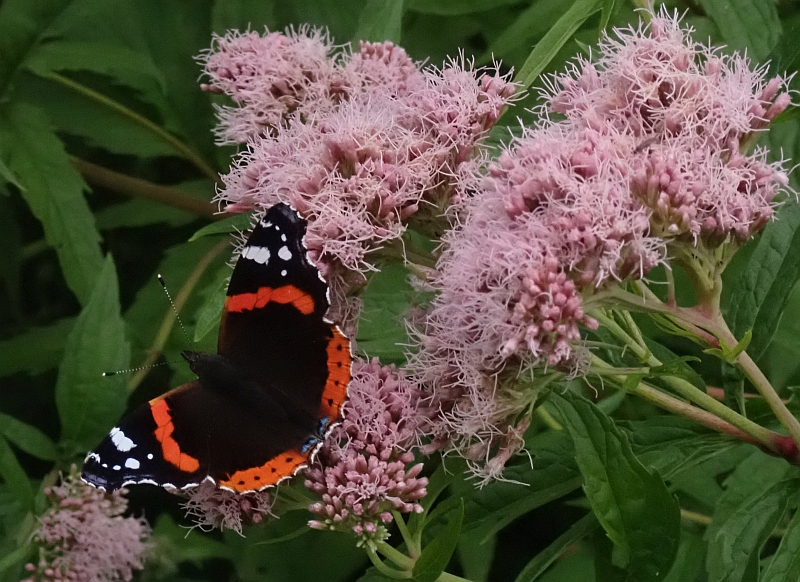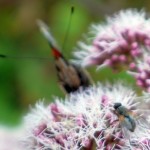 This morning, red admiral butterflies were everywhere in the garden and I counted at least 70 on both Buddleja davidii (butterfly bush / sommerfuglbusk) and Eupatorium cannabinum (hemp agrimony / hjortetrøst) was particularly densely covered!
This morning, red admiral butterflies were everywhere in the garden and I counted at least 70 on both Buddleja davidii (butterfly bush / sommerfuglbusk) and Eupatorium cannabinum (hemp agrimony / hjortetrøst) was particularly densely covered!
This is the second largest number of red admirals recorded in my county Trøndelag ever and the largest count this year in Norway (30 is the second largest)! Sadly, there are few other species around at the moment.
Tag Archives: Eupatorium cannabinum
The mini-pond and marginal areas
My house was given the name Bergstua by the previous owners, literally meaning house on the rock, a rocky hillside overlooking the fjord. Not a natural place for a pond. I wanted to have a pond somewhere, initially mainly for wildlife, habitat for frogs, drinking water for birds etc.
I eventually chose a small depression in the rock where the previous owners had presumably blasted a hole in order to erect a flagpole. Not being one for flags, I decided to convert this area into a pond and this involved removing both the metal support and concrete base and this took a couple of years of hard work as I also wanted to avoid machines. If it was feasible by hand I would do it by hand, even resisting an electric drill for many years. I used to come home from work and spent half an hour every day hacking at the concrete with a metal digging bar and when that was eventually removed deepening the depression in the shale-like rock (phyllite).
The hedge you can see behind the pond was Cotoneaster lucidus which has non-edible berries that not even birds take until they are desperate. We bought a rubber liner for the pond in the UK on one of our trips to visit family. I initially filled the pond and the boggy marginal areas with wild plants and creatures like water boatmen and frog spawn from lakes in the area, but regretted a few of the introductions like Equisetum fluviatile (swamp horsetail). The frogs never really thrived but a few survived for a few years and one took up residence in our septic tank…
I later gradually converted the pond to an edible pond and the hedge behind was dug out and replaced by a diverse edible/bird friendly hedge including Morus alba, Crataegus, Viburnum edule, Sambucus nigra “Variegata”, Viburnum opulus, Amelanchier “Thiessen”, Rosa spp., Staphylea (bladder nut) and a few others. About 10 years ago, I overhauled the pond, digging out all the soil and replanting from scratch in order to remove all the horsetail and other aggressive plants. Below is a video of my little collection of water and bog plants this week and below the video is list of plants we see:
Featuring the following plants:
Gunnera tinctoria (G. chilensis) is one of the 80 in my book Around the World in 80 plants (ATW80)
Althaea officinalis (Marsh mallow/ legestokkrose)
Allium validum (Swamp onion, Pacific onion) which is also included in ATW80
Caltha leptosepala (Western marsh marigold, White marsh marigold / hvit soleihov)
Darmera peltata (Umbrella plant, indian rhubarb / skjoldsildre)
Lilium canadense ssp michiganense (Canada lily, Michigan lily / Canadalilje)
Saxifraga pensylvanica (Swamp saxifrage) is also in ATW80
Typha angustifolia (Reedmace, bulrush, cattails / smal dunkjevle)
Filipendula ulmaria “Variegata” (Meadowsweet / mjødurt)
Polygonum hydropiper (Water pepper / vasspepper)
Eupatorium cannabinum (Hemp agrimony / hjortetrøst) (for insects and butterflies)
Zizania latifolia (Manchurian wild rice) – not very useful as it’s the swollen stems infected by a fungus which is used.
Lycopus spp.
Apium nodiflorum (Fool’s watercress, European marshwort)
Oenanthe javanica (Water dropwort, seri)




